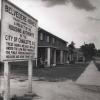Advanced Search
St. Mark's Lutheran remains the oldest Evangelical Lutheran Church in Charlotte. Worship services were first held in 1859.
The joy of coming home can be seen on the faces of these veterans from North Carolina. Front row, left to right: Cpl. Guy R. Thornton of 2324 Chesterfield Ave., Charlotte; Cpl. Howell T. Ballard of Kannapolis; and Cpl. Robert D. Byram of 3008 Dogwood Ave., Charlotte. Standing left to right: Pvt.
1. Fun Facts
◾ First Time Events
◾ New Words
◾ Cost of Living
◾ Things Familiar
◾ Things Unknown
◾ Winter Wonders
◾ Holiday Gifts
This cemetery is owned by the City of Charlotte and is the largest cemetery in the county. It was organized in 1851. Section K was divided by 3 early churches-First Presbyterian, Second Presbyterian and Brevard St. Methodist. Originally, the cemetery was for whites only.
Many of Charlotte's African-American families have lived in the Beatties Ford Road area for decades.
Many of Charlotte's African-American families have lived in the Beatties Ford Road area for decades.
Thad Lincoln Tate (1865-1951) was one of Charlotte's earliest and most prominent African American businessmen. He came to Charlotte as a barber. In 1882, he opened his own shop, an enterprise that he would operate for 61 years.
The following items have been added to the Carolina Room collection in August of 2019:
Dr. John Taylor Williams (1859-1924) was a prominent figure in the history of African-Americans in Charlotte. Not only was he one of the first three black doctors licensed in North Carolina, Williams also served an educator and a businessman.
Affordable Housing
Early projects were intended to replace substandard housing for both whites and blacks. Occupants were required to be “natural or cohesive American families.”
In 1829 and again in 1830, the Mecklenburg County Court authorized citizens to buy land “for building a poor house” and then for constructing the structu
News…From the Carolina Room
Jane Johnson
Manager, Robinson-Spangler Carolina Room
Main Library, 310 N. Tryon, Charlotte, NC
The following titles have been added to the Carolina Room collection in the month of September, 2019:
Abercrombie, Janice L. Virginia revolutionary "publick" claims, V 1-3
Building regional libraries required a patron in the community, a person or institution whose support made possible a bigger, more fully equipped building than the county could












